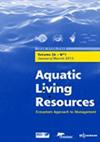Genetic variation of Parapenaeopsis sculptilis (Decapoda, Penaeidae) and reassessment of the phylogenetic relationships within the genus Parapenaeopsis based on mitochondrial DNA variation
IF 1.9
4区 农林科学
Q3 FISHERIES
引用次数: 0
Abstract
The genus Parapenaeopsis is an important group of marine shrimps for wild capture in the Indo-West Pacific region. Phylogenetics of penaeid shrimps is still a debatable issue. This study focuses on the phylogenetic relationships among seven species within the genus Parapenaeupsis, the population genetic variation of Parapenaeupsis sculptilis along Bangladesh coastline of the Bay of Bengal and the phylogeography of P. sculptilis in the Indian Ocean region by analysing cytochrome oxidase subunit 1 barcode (CO1) sequence. No population structure was detected in P. sculptilis collected from two sampling sites along the Bangladesh coastline (AMOVA and Φ ST = ‑0.014, p > 0.05; F ST = 0.061, p = 0.04), which expanded first around 73 (CI: 36‑119) kyr ago. The genealogical relationships in Bangladesh P. sculptilis population are shallow with haplotype diversity (h) of 0.58 and nucleotide diversity (π) of 0.0014. The different P. sculptilis samples from Bangladesh, India and Mozambique of the Indian Ocean revealed connectivity between western Indian Ocean and the Bay of Bengal. The phylogeny within the genus Parapenaeupsis showed a polyphyletic relationships for P. hardickwii and its taxonomy needs to be reevaluated. The study will help for genetic upgradation in aquaculture and monitoring of the population genetic diversity of P. sculptilis.
雕刻拟虾(十足目,对虾科)的遗传变异及基于线粒体DNA变异的拟虾属系统发育关系的重新评估
副虾属(Parapenaeopsis)是印度-西太平洋地区重要的野生捕获海虾群。对虾的系统发育仍然是一个有争议的问题。本研究通过细胞色素氧化酶亚基1条形码(CO1)序列分析,探讨了副虾蛄属(Parapenaeupsis) 7种间的系统发育关系、孟加拉湾孟加拉国沿岸雕刻副虾蛄(Parapenaeupsis sculptilis)种群遗传变异以及印度洋地区雕刻副虾蛄(P. sculptilis)的系统地理特征。在孟加拉国海岸线的两个采样点(AMOVA和Φ ST =‑0.014,p >;0.05;F ST = 0.061, p = 0.04),该指数在73年前(CI: 36 - 119)左右首次扩张。孟加拉石竹种群的亲缘关系较浅,单倍型多样性(h)为0.58,核苷酸多样性(π)为0.0014。从印度洋的孟加拉国、印度和莫桑比克采集的不同的雕刻假单脚虫样本揭示了西印度洋和孟加拉湾之间的联系。副带绦虫属的系统发育表明其与哈迪克氏带绦虫属存在多系关系,其分类有待重新评估。该研究将有助于水产养殖的遗传升级和石斑鱼种群遗传多样性的监测。
本文章由计算机程序翻译,如有差异,请以英文原文为准。
求助全文
约1分钟内获得全文
求助全文
来源期刊

Aquatic Living Resources
农林科学-海洋与淡水生物学
CiteScore
2.30
自引率
0.00%
发文量
10
审稿时长
>24 weeks
期刊介绍:
Aquatic Living Resources publishes original research papers, review articles and propective notes dealing with all exploited (i.e. fished or farmed) living resources in marine, brackish and freshwater environments.
Priority is given to ecosystem-based approaches to the study of fishery and aquaculture social-ecological systems, including biological, ecological, economic and social dimensions.
Research on the development of interdisciplinary methods and tools which can usefully support the design, implementation and evaluation of alternative management strategies for fisheries and/or aquaculture systems at different scales is particularly welcome by the journal. This includes the exploration of scenarios and strategies for the conservation of aquatic biodiversity and research relating to the development of integrated assessment approaches aimed at ensuring sustainable and high quality uses of aquatic living resources.
 求助内容:
求助内容: 应助结果提醒方式:
应助结果提醒方式:


